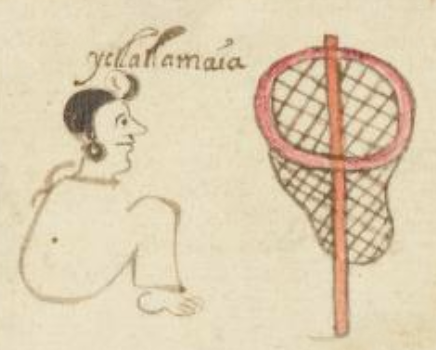tlatlama (Azca18)
This painted black-line drawing of the iconographic example of a fishing net is part of a scene with a seated man, and a gloss explaining that “with it he used to fish” (or perhaps take captives). The net looks much like the glyphs called matlatl. The net has a vertical handle that is painted brown. At the top of the handle is a red circle, and a large sock-like net is attached to the circle. The net is a mesh pattern. We are including this in the lexicon as the word tlatlama, in this case meaning to fish.
Stephanie Wood
Compare this example of iconography to the various matlatl (fishing net) glyphs below. Some of these nets are found in glyphs that refer to Tolocan (Toluca today), given that it was a city located in the Matlatzinca realm west of the Valley of Mexico. The appearance of birds in the contextualizing image may suggest that the net might be used for catching birds, too.
Stephanie Wood
yc tlatlamaia
ic tlatlamaya
Stephanie Wood
post-1550, possibly from the early seventeenth century.
Jeff Haskett-Wood
redes de pesca, red de pesca, malla, pescar, cautivar, pájaros, cazar
tlatlama, to hunt, fish, or take captives, https://nahuatl.wired-humanities.org/content/tlatlama
Pescar
Stephanie Wood
The Codex Azcatitlan is also known as the Histoire mexicaine, [Manuscrit] Mexicain 59–64. It is housed in the Bibliothèque Nationale de France, and hosted on line by the World Digital Library and the Library of Congress, which is “unaware of any copyright or other restrictions in the World Digital Library Collection.”
https://www.loc.gov/resource/gdcwdl.wdl_15280/?sp=18&st=image
The Library of Congress is “unaware of any copyright or other restrictions in the World Digital Library Collection.” But please cite Bibliothèque Nationale de France and this Visual Lexicon of Aztec Hieroglyphs.





